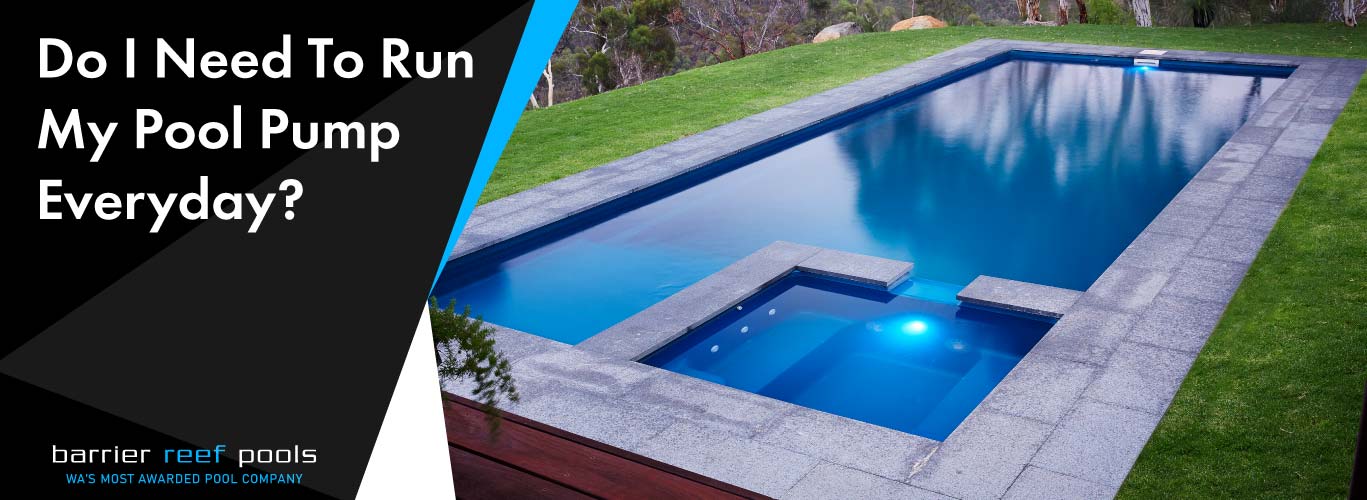You own a new pool. With a new pool come pool parties, games and relaxing dips. But that is not all. In addition to a pool’s multiple therapeutic amenities, owning a pool also comes with its own set of responsibilities. Taking good care of your pool health is an inseparable part of having a pool in your home. One method of ensuring that your pool is well-maintained is by regularly running a pool pump.
Running a pool pump is the opposite of inexpensive. Especially, if it is in an area where electricity costs higher. As a result, many pool owners think of foregoing a day or two of pool water circulation that is taken care of by a pool pump. However, not running a pool pump regularly might jeopardize the health of the water, which in turn will affect your health as well. Proper circulation of the pool water is imperative to prevent bacterial contamination and algae formation.
Hence, it is not a question of whether you should run your pool pump every day. The real question is how often or for how long you need to run the pool pump each day. We’ve tried answering this in detail to guide you through the process of learning its uses and determining how long to run it for.

How Long You Need to Run Your Pool Pump
Let’s answer the question that’s been bugging you for the longest, first. No, you do not need to run your pool pump for the whole day. The amount of time that your pool pump should run for is directly proportional to your pool volume, chemical dose, pump’s flow rate and other exterior climate factors. It’s okay to use the pool pump for whatever time it takes for all the water to be circulated once throughout the pool. If your pool volume is small enough to completely circulate the water in less than 24 hours, there’s nothing wrong with running it just for the required amount of time.
Pool pumps use a considerable amount of electricity. So we completely understand why you would want to get away with running it for as little time as possible. The trick is to know the dimensions of your pool and understand how the weather affects your pool health. Once you have this figured out, you’ll have your answer to running the pool just long enough to keep it from becoming the dreaded green pool.
Basics Of Running A Pool Pump
Now that you’ve decided to take matters into your own hands, here’s all you need to know before getting started.
Pool Pumps
Single-speed pool pumps are the most basic of the lot. They have a set speed at which they circulate the water.
Two-speed pumps are a bit more advanced than their predecessor. These pool pumps come with, as their name suggests, two speed options. High speed for when you need quick turnover and low speed to help you save some energy.
The newest advancement in pool pumps are the variable-speed pumps. With these pumps, owners themselves set a flow rate that suits their energy expending. Another benefit of this pump is that it is extremely efficient in comparison to the two former pumps and can circulate an impressive volume even at low speeds.
Other important factors to take into account are:
The flow rate of a pool pump refers to the volume of water a pump can circulate in a set amount of time. It is usually measured in gallons per minute or gallons per hour.
Turnover rate refers to the amount of time it takes for once complete filtration or circulation cycle of the pool. It is measured in hours, or minutes in some cases. Please remember that the calculated turnover rate is the minimum required amount of time you should ideally run your pool pump, every day.
Pool volume is the water-holding capacity or the volume of a pool. Pool owners need to be aware of their pool volumes in order to calculate the turnover rates.
To calculate your pool’s volume, you first need to know the pool dimensions. After that, it’s pretty easy to calculate pool volume depending on the shape of your pool.
The standard formula for calculating most pool volumes by gallons is: length x width x average depth x 7.5. This gives the total number of gallons that fill up your pool.

Calculating Turnover Rate
Once you’ve calculated the pool volume and flow rate, knowing the turnover rate is just one step away.
To know the turnover time for one complete cycle, divide the pool volume (gallons) by the flow rate (gph). This will give you the aggregate time you need to keep your pool pump running.
If the flow rate is mentioned in gpm, just multiple the given number by 60 to convert it into gph.
Just leave your pool pump on for the calculated time, and it would be protected against contamination. Fortunately, fibreglass pools can remain healthy with just one circulation per day, as compared to the double turnover required to keep regular concrete pools healthy.
Pool Volume ÷ Flow Rate = Turnover Rate
Things To Remember
- On days with larger chemical doses, you might need to run your pool pump for more than the regular turnover time.
- Pool pumps should be run for one complete cycle at least once a day.
- Running a pool pump during the day, when bacterial and algae formation is more likely, is more effective than running it during the night.
- The average turnover for domestic pools is around 8 hours. Spa pools and smaller pools take mush less time than this.
- Places with warmer climates are more prone to promoting bacterial growth in stagnant pools. For such places, you might need to run your pool pumps for much longer than one circulation.
- Pool pumps alone cannot clean a pool. They require assistance from other pool equipment to keep the pool healthy.
- Smart and regular use of the pool pump can extend pool life.
- In case of increased pool usage, with more people than an average day, it is important to leave the pool running for a whole day.
- Run a pool pump in winters if you haven’t winterized your pool to keep the water from freezing.
The final verdict is that, ideally a pool pump should be run at least once a day. This ensures that all the chemicals are homogeneously spread throughout the water and it remains safe for use. On average, one turnover is enough to keep the water from going bad or to keep the pool clean. Cloudy waters are not always a sign of poor pool health, but running a pump can also help deal with that problem. Hence, pool pumps are an important aspect of owning a pool. Their judicious use can greatly improve the water cycle and even decrease energy costs.


